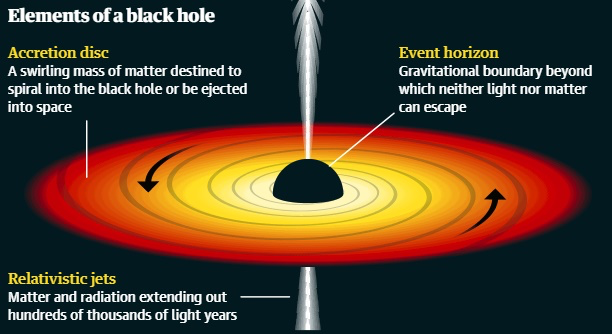Science & Technology
Moving Black Hole
- 17 Mar 2021
- 4 min read
Why in News
Scientists have discovered the first moving supermassive black hole whose mass is about three million times that of our Sun.
- The black hole was travelling within its own galaxy (J0437+2456) which is around 228 million light years away from Earth.
Key Points
- Study Conducted by the Scientists:
- Scientists studied 10 faraway galaxies with supermassive black holes in the centre, expecting them to have the same velocity as that of the galaxies they reside in.
- Focus of their study was the water in the accretion disk (the spiralling mass around a supermassive black hole made of matter that is eventually ingested by the black hole).
- As the water circles around the black hole before falling into it like liquid in a sink, it produces a laser-like beam of radio light known as a maser. These masers can tell the velocity of black holes very accurately.
- About the Moving Supermassive Black Hole:
- Of the 10 black holes they studied, only the one at the center of J0437+2456 was unusual. It was not moving at the same velocity as its home galaxy.
- Besides the empirical evidence, the enormous size of these black holes had led people to imagine them to be stationary objects planted in the middle of galaxies as opposed to objects floating around in space.
- It is moving with a speed of about 1,10,000 miles per hour inside its galaxy.
- Possible Causes for the Motion:
- Two Supermassive Black Holes Merging: Scientists might have spotted the resulting black hole moving in a rearward motion after the merger before settling down in a position.
- One in a Binary System of Black Holes, where not one but two supermassive black holes might exist within the host galaxy held together by a shared centre of gravity, which they might be orbiting.
- The twin of the newly-discovered wandering black hole might not be emitting masers, keeping it from being detected by the radio antenna network.
- Of the 10 black holes they studied, only the one at the center of J0437+2456 was unusual. It was not moving at the same velocity as its home galaxy.
Black Hole
- It refers to a point in space where the matter is so compressed as to create a gravity field from which even light cannot escape.
- The concept was theorized by Albert Einstein in 1915 and the term ‘black hole’ was coined in the mid-1960s by American physicist John Archibald Wheeler.
- Usually, the black holes belong to two categories:
- One category ranges between a few solar masses and tens of solar masses. These are thought to form when massive stars die.
- The other category is of supermassive black holes. These range from hundreds of thousands to billions of times that of the sun from the Solar system to which Earth belongs.
- In April 2019, the scientists at the Event Horizon Telescope Project released the first-ever image of a Black Hole (more precisely, of its shadow).
- The Event Horizon Telescope is a group of 8 radio telescopes (used to detect radio waves from space) located in different parts of the world.
- Gravitational waves are created when two black holes orbit each other and merge.





